Fujifilm Finepix F50 Review
Fujifilm Finepix F50 Introduction
The Fuji Finepix F50 is an evolution of both the F31fd and the F40fd. While the F50's feature set comes from the F31fd with its shutter and aperture priority modes not found on most ultra-compact digital cameras, its design closely resembles the F40fd. As the new F-series flagship, the Fuji Finepix F50 features a new 12 megapixels sensor and image stabilization. At the same time, Fuji added some new pixel-binning modes to achieve ISO sensitivities up to 6400 at lower image resolutions.
Major features of the Fuji Finepix F50 include:
- 12 Megapixels SuperCCD SR sensor.
- 3X optical zoom, equivalent to 35-105 in 35mm terms.
- CCD-shift image stabilization.
- ISO 100 to 1600 at full-resolution.
- ISO 3200 at 6 megapixels and ISO 6400 at 3 megapixels.
- Auto ISO with maximum of 400, 800 or 1600.
- 1/2000-8s Shutter-speed range.
- Shutter-priority and aperture-priority exposure modes.
- Fully automatic exposure.
- Multi-segment, average and spot-metering.
- Exposure compensation -3..+3 stops in 1/3 EV increments.
- Automatic white-balance, preset while balance and custom white-balance.
- Several continuous-drive modes, 2s or 10s self-timer.
- Normal, vivid and B&W color mode.
- 640x480 30 FPS movie-mode, up to 2 GB.
- Built-in flash with auto, forced-on, forced-off, red-eye and slow-synchro modes.
- 2.7” LCD 230K Pixels.
- Lithium-ion battery operated.
- Support for xD and SDHC cards in single combined slot.
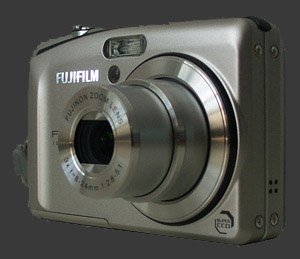
Note that Fuji sometimes uses different names for the same camera. The official name of the camera being reviewed here is Fuji Finepix F50fd, although the one we received was labeled Fuji Finepix F50SE. The SE may stand for Special-Edition, Silver-Edition (since there is also a black model) or Secret-Edition (since no trace of this name appears on the Fuji web site).
Fujifilm Finepix F50 Suitability - What is it good for?
The Fuji F50 is a general-purpose camera suitable for typical travel and social photography. Its 3X optical zoom range is now minimal among digital cameras but provides some flexibility and decent macro magnification. The main attraction of Fuji F-series cameras has always been their high-ISO capability. While the F50 only goes to ISO 1600 at its full-resolution, this is still above the usable limit of most fixed-lens cameras. For evening and action photography, such high-ISO settings are very useful. The F50 supports ISO 3200 at the relatively lower-resolution of 6 megapixels which is still sufficient for medium sized prints. The ISO 6400 setting, which drops the resolution to 3 megapixels, may prove useful for the smallest prints and web-publishing.
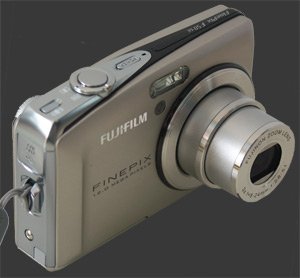
With a shutter-speed range going from 1/2000s to 8s, this digital camera is capable of freezing fast action and capturing typical urban night scenery. Note that very low-light environments are beyond the reach of the F50 because its ISO is limited to 100 for all shutter-speeds slower than 1 second. Semi-automatic exposure modes, something rarely seen among ultra-compact cameras, allow control over the capture of motion and depth-of-field. Just like all other ultra-compact cameras, the F50's small sensor causes images to have far more depth of field than with a large-sensor camera like a DSLR. Depending on the desired results, this may be an advantage or a disadvantage.
The Fuji F50 is capable of dealing with a wide variety of lighting situation in terms of both color and contrast. With numerous white-balance options, including custom white-balance, colors can be accurately captured in any situation. Flexible metering options, including spot-metering, allow the photographer to control how the F50 deals with unevenly-lit scenes. The F50 is also equipped with typical scene modes. One particular mode deserve a quick mention though: the natural light and flash takes two pictures of a scene, one with and one without flash. This saves time when not being certain which outcome would be better.
The other notable feature of the F50 is a now typical movie mode which records at 640x480 30 FPS up to a maximum file size of 2 GB. That is roughly equivalent to 70 minutes of recording. Sound is recorded during movie recording but the zoom cannot be used.
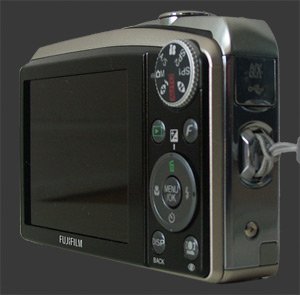
Unlike most recent digital cameras, the Fuji F50 does not automatically rotate images taken in portrait orientation. This missing feature is partly compensated by a very efficient system for rotating multiple images without exiting and re-entering the menu between each image.
This digital camera is also equipped with a face-detection mode. Face-detection is now quite common, particularly among compact and ultra-compact cameras. The basic principle is that the camera tries to recognize faces and sets the focus and exposure accordingly. Fuji goes one step-further by also using face-detection during playback so that the user can verify that face-detection worked. This variant was actually first scene on Fuji's latest DSLR, the Finepix S5 Pro. The same face detection system can also be used to remove red-eye during playback. This feature plus high-ISO capabilities really emphasize the Fuji F50 a camera well-suited for social photography.
Fujifilm Finepix F50 Usability - How easy is it to use?
What keeps the F50 secure is truly Fuji's sturdy wrist-strap which has a tightening element for added security. The camera itself is easy to hold thanks to a slight grip on the camera's front. Unfortunately, the F50's mode-dial is misplaced right under your thumb and feels insecure while gripping the camera. The remaining buttons, including the 4-way control-pad, are just below the mode-dial and are easy to accidentally press. Because the camera is rather small and features a large 2.7” LCD screen, there is no free space to rest your thumb. The situation would have been better if the mode-dial were place on top of the camera as it is with some ultra-compact cameras.
Since the F50fd is smaller and has a larger screen than its design-predecessor, the Fuji F40fd, it is great to know that ergonomics are no worse than before. In fact, two minor changes make the F50 marginally better to handle than the F40fd. First, the protrusion which serves as a hand-grip on the camera's front now covers the whole height of the camera. Second, the tripod mount is no longer at the edge of the camera. Still, the tripod mount is not in-line with the camera's lens as it was with the Fuji Finepix F10.
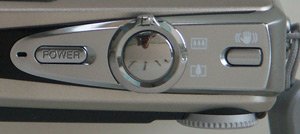
The shutter-release and surrounding zoom controller are easy to use and very responsive. Pictures are taken nearly instantly and the lens zooms rapidly from one end of the zoom-range to the other. All other buttons provide instant feedback too, unless the camera is writing an image to memory which is indicated by a steady orange light next to the mode-dial. The 4-way controller has functions assigned to each direction for quick access to flash-modes, macro-mode, self-timers and exposure compensation. The is also a F-button, found on nearly all Fuji cameras, which provides quick access to ISO, image resolution and color-modes settings. Every time we review a Fuji camera, we wish that they would at least add white-balance there instead of image resolution and color modes which are rarely changed by most users.
New to the F-series is, of course, the image stabilization button. This button appears on top of the camera to the left of the shutter-release. It functions as a simple toggle between having the stabilizer off and the selected stabilization mode. To actually select the stabilization mode, the setup menu must be used. There are two stabilization modes, one which works continuously and therefore stabilizes the preview and another which only stabilizes during exposure. These two modes are unimaginatively called Mode 1 and Mode 2, which frankly does not help in knowing which one is which.
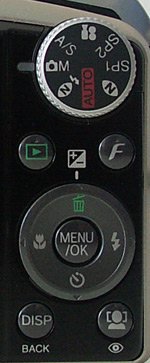 The 2.7” LCD screen itself is simply superb. Outdoor visibility is excellent, even in direct sunlight. The anti-reflective coating really does its job well. Images on the screen are sharp and fluid. The display also has a clear mode which is activated using the F-button menu. In this mode, the F50's LCD refreshes at a higher rate and maintains a very fluid preview while providing a brighter image. This may be useful in extreme sunlight but keep in mind that exposure is not accurately previewed in this mode. It does maintain image clarity better than the LCD brightness boost found in previous F-series models.
The 2.7” LCD screen itself is simply superb. Outdoor visibility is excellent, even in direct sunlight. The anti-reflective coating really does its job well. Images on the screen are sharp and fluid. The display also has a clear mode which is activated using the F-button menu. In this mode, the F50's LCD refreshes at a higher rate and maintains a very fluid preview while providing a brighter image. This may be useful in extreme sunlight but keep in mind that exposure is not accurately previewed in this mode. It does maintain image clarity better than the LCD brightness boost found in previous F-series models.
This camera is well constructed with a sturdy metal body. As usual, the compartment door is the weak point. Both the battery and memory are found behind the compartment door. The battery is held in place with a latch so that it does not fall out while changing memory cards. Like most recent Fuji cameras, the memory card slot accommodates both xD, SD and SD-HC cards, one at the time. Since SD cards are the cheapest form of flash memory and are generally much faster than xD cards, we recommend using SD cards instead of xD ones. Unlike some of its predecessors, the Fuji F50 comes with a charger for its battery. This is much better than in-camera charging which locks down the camera while a battery is being charged.
The Fuji F50 is mostly a point-and-shoot digital camera. As such, it is very easy to use. The menu system is simple and easy to navigate. There are a few obscure items though. Understanding them requires a reading the manual. The Power Management options for example are: Power Save, Quick AF and Clear Display.
There are two positions on the mode-dial for scene modes, so the menu is used to select which scene-mode is active. The difference is that they each remember the last chosen scene mode separately.
The full menu of the Fuji F50 is called by the Menu button. It is organized as a single-level menu system with one of the options activating a multi-page setup menu. Several common settings such as white-balance and metering require the use of this menu. There is a dedicated button to enter playback mode.
 |
Please Support Neocamera
All information on Neocamera is provided free of charge yet running this website is a huge endeavor. Purchases made via affiliate links found throughout the site help keep it running and up-to-date. There is no additional cost to you, so please consider buying via these links to our affilates:
If you found any information on this site valuable and did not purchase via our affiliate links, please considering donating via PayPal:
Any amount will be greatly appreaciated. Thank you for your support!
Fujifilm F50 Highlights

Sensor-Size: 8 x 6mm

Actual size when viewed at 100 DPI
| 12 Megapixels Ultra Compact | ISO 80-1600 |
| 3X Optical Zoom | Shutter 1/2000-8s |
| Built-in Stabilization | Custom white-balance |
| 2 FPS Drive, 3 Images | Spot-Metering |
| 640x480 @ 30 FPS Video Recording | Lithium-Ion Battery |
| 2.7" LCD 230K Pixels | Secure Digital High Capacity, xD Internal Memory |
Updates
2025.01.18

Fujifilm GFX 2025 Lens Roundup
Lens Review roundup of Fujifilm GFX Medium-Format lenses. Quality, performance and handling of the GF20-35mm F/4R WR, GF30mm F/3.5 Tilt-Shift and the GF55mm F/1.7.
2024.11.18

Best 2024 Photography Gifts for Every Budget
Great gifts for photographers and photo enthusiasts selected for every budget among the best products of 2024.
2024.08.07

Eye Protection Tips for Professional Photographers
The four main considerations for professional photographers regarding eyewear.
2024.07.14

Fujifilm X100VI Review
Flagship fixed-lens compact digital camera with a 40 MP sensor and Image-Stabilization, a first for the series. Retro design featuring dual control-dials, plus direct ISO, Shutter-Speed and EC dials. Its hybrid viewfinder can switch between EVF and OVF mode.
2024.05.09

Fujifilm GFX100 II Review
Flagship 102 Megapixels Medium-Format Mirrorless Digital Camera with 8-Stop 5-Axis IBIS, 8 FPS Drive, 8K Video and 400 MP Super-Resolution capture in a weatherproof and freezeproof body with dual control-dials and dual memory-card slots.
2024.04.03

Fujifilm X-T5 Review
Newest Fujifilm flagship boasting a 40 MP APS-C sensor, 5-axis IBIS with 7-stop efficiency, 15 FPS continuous drive, 6.2K Video capture, dual control-dials and dual SDXC UHS-II slots in a sturdy weatherproof and freezeproof body.
2023.11.20

Best Digital Cameras of 2023
Find out which are the Best Digital Cameras of 2023. All the new Mirrorless Digital Cameras from entry-level to high-end professional.
2023.07.10

Fujifilm X-H2 Review
40 Megapixels APS-C Hybrid Mirrorless Digital Camera with 7-stop IBIS. Fastest shutter ever and 8K video capture. Large builtin EVF with 0.8X magnification and 5.8 MP, plus an Eye-Start Sensor. Packed with features and large number of controls in a weatherproof and freezeproof body.
2023.05.07

Sony FE 20-70mm F/4G Review
Review of the unique Sony FE 20-70mm F/4G lens. The optical zoom of this lens spans ultra-wide-angle and medium focal-length coverage, making it one of the most versatile Full-Frame lenses on the market.
2023.01.15

Huion Inspiroy Dial 2 Review
Review of the Huion Inspiroy Dial 2 tablet, a medium sized drawing surface with dual dials and customizable buttons. Connects via USB-C or Bluetooth 5.0 with Windows, Linux and Android support.
2022.12.08

How to Pack for a Photo Trip
Find out how to pack for a travel photography trip, carry your gear safely while meeting airline regulations.
2022.11.13

Best Digital Cameras of 2022
The best digital cameras of 2022. A short list of the most outstanding models in their respective categories. Choose one for yourself or as a gift.











